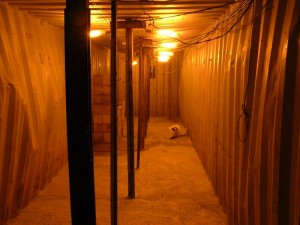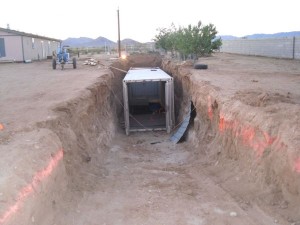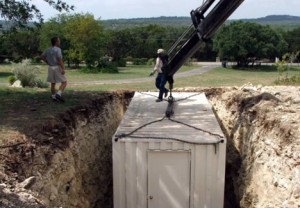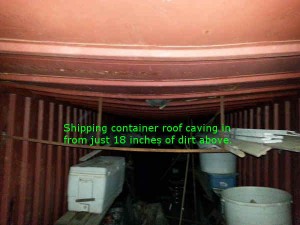Short answer; no! The full or partial burying of shipping containers or connexes has been very popular for the last decade among the prepping community. You can see it on you tube and programs such as doomsday preppers. The appeals stems from many things, easy availability, relatively low cost, a prefab structure, and an optimal size for many preppers. But there are some major issues to consider before you bring in the backhoe and crane.
A quick caveat is that if you are building an above ground shelter then more power to you. Shipping containers will last years and years above ground if maintained, and can be converted into shelters easily. In the Middle East many soldiers lived in shipping containers on established bases, called CHUs (container housing unit). Just don’t cover it with dirt, even partially.
There are two main factors that contribute to the unreliable nature of shipping containers, they are not designed structurally to handle this type of usage and they are prone to corrosion when exposed to moisture.
At a glance a shipping container doesn’t look all that different from prefab bunkers made by several survival construction companies. They also don’t seem that farfetched when considering how many bulk liquid storage tanks are used all around us every day. If we can bury those tanks, why not a connex?
Underground storage tanks are actually built to extremely high specifications reflecting the difference in engineering design from simple shipping. The steel walls for an underground storage container in 5/16s of an inch in accordance with federal regulation for single wall underground steel storage tanks; that’s roughly 1/4th of an inch or 7.9 mm’s. Shipping containers on the other hand are built for purpose; or form follows function. That have strong frames allowing them to be hoisted and stacked to great heights, and have reinforced floors to carry heavy loads; but the walls are often little more than 1/16th inch thick. That’s just 1.6 mm’s; and that’s not much even with strengthening from the corrugated design.
So what is the corrosion difference between shipping containers and other subterranean containers? Shipping containers are manufactured of corrosion resistant corten steel, as they do have to withstand saltwater exposure and other shipping conditions; but most companies still put little more than a 3-5 year warranty on a new container. While corten steel does display great longevity when compared to untreated steels and alloys, and is by no means corrosion proof and shipping containers in use have to be regularly cleaned, patched, repaired, and repainted.
Underground containers on the other hand focus on a non metallic moisture barrier and utilize a 360 degree coating of polyurethane at least 70 mil thick with an epoxy top coat. Unfortunately this coated is substantially different that latex paints and enamels and requires specialized application, that I for one don’t have the skills or tools to accomplish.
For my part, when I get around to building my actual bunker, I think it will involve cinder blocks and concrete. I like these blocks because they can be stacked to fit personal design and specifications, and can be hauled into an area without arising great suspicion. A special courtesy nod to containerhome.info for some great information and specifications on dimensions.
Jon









Leave a Reply